
Wine Culture and Information since 2002 - Volume 22
 Wine Culture and Information since 2002 - Volume 22 |
|
Chenin BlancOriginating from the Loire Valley, Chenin Blanc is a grape with a twin personality, frequently used for the production of ordinary wines, it is also capable of giving full bodied and longeval white wines |
|
Chenin Blanc probably is among the most underrated grapes of the worldwide wine scene. The many and too much interpretations of the past contributed to this deprecable noble image, in times when it was generally used for the production of ordinary wines. The excessive use of sulfur dioxide and its high productivity have contributed to the production of huge quantities and pretty ordinary qualities. Indeed wines produced with Chenin Blanc - at least in cases it is properly used - are capable of long period of aging in bottle, so long that they can even compete with Riesling, probably the most longeval white berried grape in the world. Chenin Blanc is a pretty versatile grape, maybe too much, and this quality has negatively contributed to its popularity. Nevertheless in the best interpretations this grape is capable of giving wines with interesting organoleptic qualities, from dry wines to sweet and botrytized ones, and even sparkling wines. The name of this grape derives from Mont-Chenin, in the district of Touraine, and it is probably dated back to the fifteenth century. The sure origins of Chenin Blanc are however older than that and there are evidences of this grape in the Anjou area - in the Loire Valley - since 845 AD. The main organoleptic characteristic of Chenin Blanc is acidity - probably second to Riesling only - a thin skin and a pretty high quantity of natural sugar, qualities which make it very suited for the production of sparkling wines and sweet wines, however the grape is also used for the production of dry wines. In favorable conditions, Chenin Blanc is very sensitive to the effects of noble rot - the renowned Botrytis Cinerea - a quality which allows the production of interesting botrytized and moelleux wines, to say it like the French do. In its homeland - Loire Valley - Chenin Blanc is usually called Pineau de la Loire, whereas in South Africa, where Chenin Blanc is the most common white berried grape, is called Steen. As already mentioned, the main quality of Chenin Blanc is its natural high acidity, a characteristic this grape is capable of keeping both in cool climate areas and in warm climate ones. However in cool climate areas, such as the Loire Valley when meteorological conditions are not favorable, as well as when it is cultivated with high yields, the acidity tends to excessively prevail without being properly balanced by the other organoleptic qualities. This characteristic is considered interesting in warm climate areas - such as South Africa, the central part of California and Argentina - because it allows to have grapes with optimal levels of acidity even at full ripeness. The quantity of sugar is pretty high as well, a quality which interested producers of the past to make off-dry wines - and most of the times ordinary as well - to which were added high quantities of sulfur dioxide in order to prevent any accidental refermentation in bottle although with deprecable effects on the organoleptic qualities of wine.
The direct consequence of this production system has led many producers in the Loire Valley to uproot their Chenin Blanc vineyards in favor of other varieties, including Cabernet Franc. Nevertheless it is indisputable this grape, when properly used, shows an interesting versatility and, thanks to its acidity, Chenin Blanc is very suited to the production of sparkling wines and ensures optimal balance in sweet wines. Moreover, last but not the least, in white wines - as well as in red wines - acidity also means longevity, a quality Chenin Blanc shares with other very few white berried varieties, such as Riesling. Despite Loire Valley is the homeland of Chenin Blanc, the largest acreage cultivated with this variety are located in South Africa and California. Acreage records apart, Loire Valley remains the area from which are being produced the best wines with this grape and - in particular - in the areas of Vouvray and Touraine. Chenin Blanc is a variety which can be adapted to different climates and to different soil types and, in particular, is always capable of ensuring optimal levels of acidity and high yields. These two characteristics are very interesting for the production of bulk wines because even with high yields, Chenin Blanc ensures wines with good acidity. Just like any other grape, even Chenin Blanc prefers specific types of soil and particular climates, in which it is capable of giving extraordinary results. To these conditions it should be added a proper cultural technique for quality production that in Chenin Blanc, as well as for other grapes, must be very low and distant from the concepts of quantitative production. Chenin Blanc is a variety which tends to sprout in advance and to ripe pretty late, a cultural condition which can also be cause of problems in cool climate areas, such as in Loire Valley. Chenin Blanc is usually used for the production of monovarietal wines, however it is also frequent, even in the Loire Valley, that to this grape is added a certain quantity of Chardonnay in order to mitigate its excessive acidity. Its thin skin makes it very sensitive to the effects of noble rot, a common and looked for quality in sweet wines. The best examples of Chenin Blanc wines - in every style - are the ones exclusively produced with this grape, however it is good to remember that still today Chenin Blanc is very used for the production of bulk ordinary wines, in which the presence of sulfur dioxide is pretty evident both in the aromas and in the taste. Thanks to its acidity, quality Chenin Blanc wines are very suited to long period of aging that can also be as long as tens of years, such as in case of wines produced in the small area of Savennières, in the Loire Valley.
|
||||||||
|
The colors of wines produced with Chenin Blanc varies according to the production style. In fact, this grape is used for the production of many different styles of wines, from sparkling wines to sweet and botrytized wines. Moreover, even though this practice is pretty limited with Chenin Blanc, any possible fermentation and aging in cask influences color as well. The spreading of this grape in the world is pretty limited, however climate and ripeness influence its color. Sparkling wines produced with Chenin Blanc show colors from greenish yellow to straw yellow, a color which is also found in dry and off-dry wines. The color of sweet and botrytized wines tend to deeper hues of golden yellow, as well as in dry and off-dry wines produced in warm climate regions. With time, that in Chenin Blanc can also be some tens of years, the evolution of color is similar to other white wines and will show intense golden yellow hues at the top of its aging.
|
|
The aromatic characteristics in Chenin Blanc are strongly influenced by quality, a factor which is however and always true for every grape and for every wine. In case of Chenin Blanc, this premise is probably necessary as this grape is still today widely used for the production of bulk wines because of its high productivity and that however ensures wines with good acidity. In bulk wines aromas are pretty ordinary, almost anonymous, and which can be easily confused with all the other wines of similar quality. Chenin Blanc in order to give its best in aromas, requires quality cultural and enological practices. Wines produced in cool climate areas or with not fully ripe grapes, develop aromas of green apple, lemon, citrus fruit, acacia and, sometimes, melon. Wines produced in warm climate areas or ripe grapes, develop aromas of ripe apple, honey, lemon, peach, quince, apricot, melon and frequently aromas of grape, typical in aromatic varieties. Wines produced with Chenin Blanc are pretty suited to long aging in bottle, however it is good to remember this quality exclusively belongs to high quality wines in which the aromatic bouquet improves with time. With time Chenin Blanc wines generally develop aromas of honey, beeswax, musk, lanolin and quince jam. Wines produced with Chenin Blanc grapes affected by Botrytis Cinerea - the noble rot - besides the typical aromas derived from its effects, develop aromas of raisin, marzipan, quince jam, honey and aromas of spices. In wines produced with this grape and fermented or aged in cask - a pretty limited practice with Chenin Blanc and which is sometimes used for sweet or botrytized wines - can be perceived the typical aromas passed from wood to wine, qualities which strongly vary according to the toast level of the cask as well as to the time of aging.
|
|
The main gustatory characteristic of Chenin Blanc is acidity, a pretty strong quality and which strongly contributes to the balance of sweet wines produced with this grape. Acidity is also a quality which makes Chenin Blanc suited to the production of sparkling wines. Its wines usually have medium-high quantity of alcohol, however the most frequent percentage is of about 12.5%. The structure in wines produced with Chenin Blanc is pretty high, to be considered among the most robust in white wines. Chenin Blanc's acidity represents the main gustatory element and this quality is clearly appreciable since the first sip. To balance the high acidity contributes alcohol and, in particular, the sweetness of sweet and botrytized wines. Dry or off-dry Chenin Blanc wines are usually produced with structures from light to full bodied. In light wines crispness will be high, whereas in full bodied wines the higher structure will give a greater vigor to the wine while keeping an appreciable acidity.
|
|
The indisputable homeland of Chenin Blanc is Loire Valley - in France - and in particular in the central area. Wines from Touraine are produced in many styles, from sparkling to sweet. Wines from Savennières are pretty rare, however in the best years here are being produced high quality wines, dry and full bodied, most of the time characterized by mineral and black pepper aromas because of the volcanic soil. In the southern area of the Loire river are found the interesting Coteaux du Layon AC and Coteaux de l'Aubance AC in which are being produced off-dry and sweet wines. The most renowned sweet Chenin Blanc wines produced in the Loire Valley are the ones from Bonnezeaux and Quarts de Chaume - both located in the Coteaux de Layon area - with pretty complex characteristics, most of the times produced with grapes affected by Botrytis Cinerea. Other interesting areas for Chenin Blanc in the Loire Valley are Vouvray and Montlouis. In these areas, because of the limestone soil, are being produced lighter and less bodied wines than the ones produced in the Anjou area. Wines from Vouvray and Montlouis are appreciated for their elegance and finesse with very good organoleptic evolution with aging. Wines from Vouvray certainly are among the most famous Chenin Blanc wines from Loire Valley and frequently represent the reference model for other areas outside France in which this grape is cultivated. Chenin Blanc is also found in South Africa - here known as Steen and which represents the most cultivated grape of the country - used for the production of dry, sweet and sparkling wines. In South Africa Chenin Blanc is mainly used for the production of bulk wines, however with this grape are also produced interesting late harvest wines. Chenin Blanc is pretty common in California as well - and in particular in the Central Valley - mainly used for the production of bulk wines, most of the times added with sugar in order to balance the strong acidity. In recent times Californian producers are revaluating this grape in the aim of producing quality wines in the Vouvray style. Marginal productions of Chenin Blanc are also found in Australia and in New Zealand.
|
||||
Wines of the Month |
|
|
|
Score legend Prices are to be considered as indicative. Prices may vary according to the country or the shop where wines are bought |
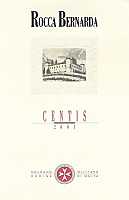
|
|
Colli Orientali del Friuli Merlot Centis 2001 |
|
| Rocca Bernarda (Italy) | |
| Grapes: Merlot | |
| Price: € 17.50 | Score: |
| This Merlot shows a brilliant ruby red color and nuances of garnet red, little transparency. The nose reveals intense, clean, pleasing and refined aromas which start with hints of black cherry, plum and black currant followed by aromas of vanilla, blueberry, bell pepper, licorice, cocoa, cinnamon and hints of hay. In the mouth has good correspondence to the nose, a slightly tannic attack and however well balanced by alcohol, full body, intense flavors, good tannins, agreeable. The finish is persistent with flavors of plum, black cherry and black currant. A well made wine. Merlot Centis is aged for 15 months in barrique followed by an aging in bottle for at least 8 months. | |
| Food Match: Braised and stewed meat, Roasted meat, Hard cheese | |
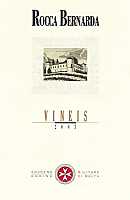
|
|
Colli Orientali del Friuli Bianco Vineis 2003 |
|
| Rocca Bernarda (Italy) | |
| Grapes: Tocai Friulano (80%), Sauvignon Blanc (10%), Chardonnay (10%) | |
| Price: € 11.00 | Score: |
| This wine shows a brilliant straw yellow color and nuances of straw yellow, very transparent. The nose denotes intense, clean, pleasing and refined aromas which start with hints of hawthorn and plum followed by aromas of pineapple, banana, apple, acacia, pear, grapefruit and hints of vanilla. In the mouth has good correspondence to the nose, a crisp attack and however balanced by alcohol, good body, intense flavors, agreeable. The finish is persistent with flavors of pear, plum and pineapple. A well made wine. The Chardonnay used for the production of this wine ferments in barrique. Vineis ages for 6 months in steel tanks. | |
| Food Match: Fried fish, Roasted fish, Broiled fish, Pasta with fish and crustaceans | |
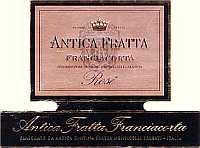
|
|
Franciacorta Rosé |
|
| Antica Fratta (Italy) | |
| Grapes: Chardonnay (60%), Pinot Noir (40%) | |
| Price: € 16.00 | Score: |
| This Franciacorta shows a pale onion skin pink and nuances of pale pink, very transparent, good effervescence, fine and persistent perlage. The nose reveals intense, clean, pleasing and refined aromas which start with hints of raspberry, cherry and bread crust followed by aromas of strawberry, banana, cyclamen, yeast, tangerine, apple and pink grapefruit. In the mouth has good correspondence to the nose, a crisp and effervescent attack, however balanced, good body, intense flavors, agreeable. The finish is persistent with flavors of raspberry, strawberry and cherry. A well made wine. This Franciacorta ages on its lees for 24 months. | |
| Food Match: Pasta and risotto with fish, Roasted fish, Sauteed white meat | |
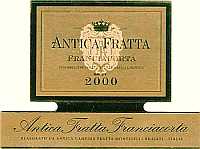
|
|
Franciacorta Brut Millesimato 2000 |
|
| Antica Fratta (Italy) | |
| Grapes: Chardonnay | |
| Price: € 18.00 | Score: |
| This Franciacorta shows a brilliant golden yellow color and nuances of golden yellow, very transparent, good effervescence, fine and persistent perlage. The nose reveals intense, clean, pleasing and refined aromas which start with hints of praline, banana and bread crust followed by aromas of acacia, hawthorn, butter, yeast, apple, kiwi and pear. In the mouth has good correspondence to the nose, a crisp and effervescent attack, however balanced, good body, intense flavors, agreeable. The finish is persistent with flavors of pear, apple and kiwi. A well made wine. This Franciacorta ages on its lees for 42 months. | |
| Food Match: Fish and mushrooms soups, Roasted fish, Stuffed pasta with meat | |
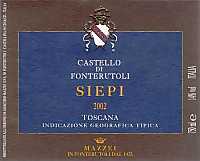
|
|
Siepi 2002 |
|
| Castello di Fonterutoli (Italy) | |
| Grapes: Merlot (70%), Sangiovese (30%) | |
| Price: € 58.00 | Score: |
| This wine shows an intense ruby red color and nuances of garnet red, little transparency. The nose reveals intense, clean, pleasing, refined and elegant aromas which start with hints of plum and black currant followed by aromas of blackberry, black cherry, blueberry, vanilla, licorice, tobacco, eucalyptus, cocoa and hints of bell pepper. In the mouth has good correspondence to the nose, a slightly tannic attack and pleasing smoothness, however well balanced by alcohol, full body, intense flavors, good tannins, agreeable. The finish is persistent with flavors of plum, black currant and black cherry. A well made wine. Siepi ages for 18 months in barrique. | |
| Food Match: Game, Roasted meat, Braised and stewed meat, Hard cheese | |
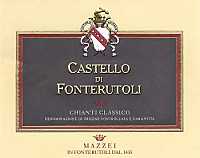
|
|
Chianti Classico Castello di Fonterutoli 2001 |
|
| Castello di Fonterutoli (Italy) | |
| Grapes: Sangiovese (85%), Cabernet Sauvignon (10%), Merlot (5%) | |
| Price: € 34.00 | Score: |
| This Chianti shows an intense ruby red color and nuances of garnet red, little transparency. The nose reveals intense, clean, pleasing and refined aromas which start with hints of black cherry, plum and blackberry followed by aromas of violet, vanilla, black currant, tobacco, licorice, cyclamen, blueberry, cocoa and eucalyptus. In the mouth has very good correspondence to the nose, a slightly tannic attack and pleasing crispness, however well balanced by alcohol, full body, intense flavors, good tannins. The finish is very persistent with long flavors of black cherry, plum and blueberry. A well made wine. This Chianti ages for 16-18 months in barrique. | |
| Food Match: Game, Roasted meat, Braised and stewed meat, Hard cheese | |
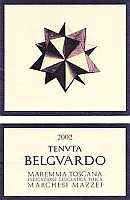
|
|
Tenuta Belguardo 2002 |
|
| Tenuta Belguardo (Italy) | |
| Grapes: Cabernet Sauvignon (70%), Sangiovese (20%), Merlot (10%) | |
| Price: € 34.50 | Score: |
| This wine shows a deep ruby red color and nuances of garnet red, little transparency. The nose reveals intense, clean, pleasing and refined aromas which start with hints of black cherry, plum and vanilla followed by aromas of blueberry, blackberry, black currant, violet, tobacco, licorice, bell pepper and cocoa. In the mouth has good correspondence to the nose, a slightly tannic attack and however well balanced by alcohol, full body, intense flavors, good tannins. The finish is persistent with flavors of plum and black cherry. A well made wine. Tenuta Belguardo ages for 18 months in cask. | |
| Food Match: Stewed and braised meat, Roasted meat, Game, Hard cheese | |
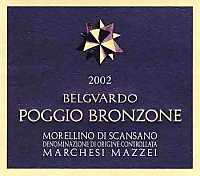
|
|
Morellino di Scansano Poggio Bronzone 2002 |
|
| Tenuta Belguardo (Italy) | |
| Grapes: Sangiovese | |
| Price: € 18.50 | Score: |
| This wine shows a brilliant ruby red color and nuances of ruby red, little transparency. The nose denotes intense, clean, pleasing and refined aromas that start with hints of black cherry and plum followed by aromas of blackberry, blueberry, violet, vanilla, licorice, tobacco and black currant. In the mouth has good correspondence to the nose, a tannic attack and however well balanced by alcohol, good body, intense flavors, good tannins, agreeable. The finish is persistent with flavors of black cherry, blueberry and plum. This wine ages in cask for 14 months. | |
| Food Match: Roasted meat, Braised and stewed meat, Hard cheese | |
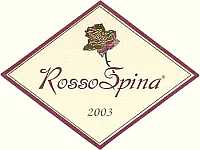
|
|
Rosso Spina 2003 |
|
| Cantina La Spina (Italy) | |
| Grapes: Montepulciano (90%), Merlot (5%), Gamay (5%) | |
| Price: € 12.00 | Score: |
| Rosso Spina shows a brilliant ruby red color and nuances of ruby red, moderate transparency. The nose denotes intense, clean, pleasing and refined aromas which start with hints of raspberry and cherry followed by aromas of cyclamen, rose, vanilla, licorice, carob and cinnamon. In the mouth has good correspondence to the nose, a slightly tannic attack and pleasing crispness, however balanced by alcohol, good body, intense flavors, good tannins, agreeable. The finish is persistent with flavors of raspberry and cherry. Rosso Spina ages in barrique for 11 months. | |
| Food Match: Roasted meat, Broiled meat and barbecue, Stewed meat, Hard cheese | |
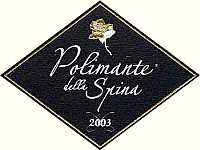
|
|
Polimante della Spina 2003 |
|
| Cantina La Spina (Italy) | |
| Grapes: Merlot (70%), Gamay (30%) | |
| Price: € 14.00 | Score: |
| This wine shows a brilliant ruby red color and nuances of ruby red, little
transparency. The nose reveals intense, clean, pleasing, refined and
elegant aroma | |
| Food Match: Game, Braised and stewed meat, Roasted meat, Hard cheese | |
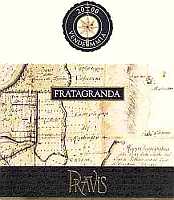
|
|
Fratagranda 2000 |
|
| Pravis (Italy) | |
| Grapes: Cabernet Sauvignon, Cabernet Franc, Merlot | |
| Price: € 15.00 | Score: |
| The wine shows a brilliant ruby red color and nuances of garnet red, moderate transparency. The nose reveals good personality with intense, clean, pleasing and refined aromas which start with hints of plum jam and black cherry jam followed by aromas of black currant, vanilla, licorice, tobacco, cocoa, mace and cinnamon. In the mouth has good correspondence to the nose, a slightly tannic attack and however well balanced by alcohol, good body, intense flavors, good tannins, agreeable. The finish is persistent with flavors of black currant and black cherry jam. A well made wine. Fratagranda ages for one year in barrique followed by six months of aging in bottle. | |
| Food Match: Roasted meat, Braised and stewed meat, Hard cheese | |
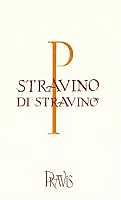
|
|
Stravino di Stravino 2002 |
|
| Pravis (Italy) | |
| Grapes: Chardonnay, Riesling, Sauvignon Blanc, Kerner, Incrocio Manzoni | |
| Price: € 18.00 | Score: |
| The wine shows an intense straw yellow color and nuances of straw yellow, very transparent. The nose reveals good personality with intense, clean, pleasing, refined and elegant aromas which start with hints of hazelnut and banana followed by aromas of apricot, butter, broom, pear, peach, raisin and hints of vanilla. In the mouth has good correspondence to the nose, a crisp attack and pleasing roundness, however well balanced by alcohol, good body, intense flavors, agreeable. The finish is persistent with flavors of peach, banana and raisin. A well made wine. Stravino di Stravino is produced with grapes harvested in different periods of which part overripe and part dried on mats, separately vinified in cask and in steel tanks. | |
| Food Match: Roasted fish with spices, Sauteed white meat, Pasta with fish and crustaceans | |
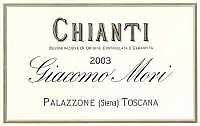
|
|
Chianti 2003 |
|
| Giacomo Mori (Italy) | |
| Grapes: Sangiovese (95%), Colorino, Canaiolo Nero (5%) | |
| Price: € 13.50 | Score: |
| This Chianti shows a brilliant ruby red color and nuances of ruby red, moderate transparency. The nose reveals intense, clean and pleasing aromas that start with hints of black cherry and plum followed by aromas of blueberry, violet, licorice and hints of vanilla. In the mouth has good correspondence to the nose, a slightly tannic attack and pleasing crispness, however balanced by alcohol, good body, intense flavors, good tannins. The finish is persistent with flavors of black cherry and plum. This Chianti ages for 10-12 in cask followed by 3-6 months of aging in bottle. | |
| Food Match: Broiled meat, Roasted meat, Stewed meat, Cheese | |
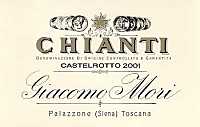
|
|
Chianti Castelrotto 2001 |
|
| Giacomo Mori (Italy) | |
| Grapes: Sangiovese (90%), Merlot (10%) | |
| Price: € 24.00 | Score: |
| This Chianti shows an intense ruby red color and nuances of garnet red, little transparency. The nose reveals intense, clean and pleasing aromas which start with hints of black cherry and plum followed by aromas of blackberry, blueberry, licorice, violet, cocoa and vanilla. In the mouth has good correspondence to the nose, a slightly tannic attack and however balanced by alcohol, good body, intense flavors, good tannins, agreeable. The finish is persistent with flavors of black cherry and plum. This Chianti ages for 15-18 months in barrique followed by 6-10 months of aging in bottle. | |
| Food Match: Roasted meat, Broiled meat, Braised and stewed meat | |
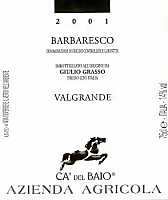
|
|
Barbaresco Valgrande 2001 |
|
| Ca' del Baio (Italy) | |
| Grapes: Nebbiolo | |
| Price: € 20.00 | Score: |
| This Barbaresco shows a brilliant ruby red color and nuanced of brick red, moderate transparency. The nose denotes intense, clean, pleasing, refined and elegant aromas that start with hints of cherry, raspberry and dried violet followed by aromas of plum, licorice, cinnamon, cinchona, tobacco, vanilla and menthol. In the mouth has good correspondence to the nose, a tannic attack and appreciable crispness, however well balanced by alcohol, full body, intense flavors, good tannins. The finish is persistent with flavors of cherry, raspberry and plum. A well made wine. This Barbaresco ages for 15 months in cask. | |
| Food Match: Game, Roasted meat, Braised and stewed meat, Hard cheese | |
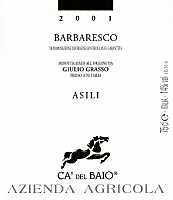
|
|
Barbaresco Asili 2001 |
|
| Ca' del Baio (Italy) | |
| Grapes: Nebbiolo | |
| Price: € 20.00 | Score: |
| This Barbaresco shows a brilliant ruby red color and nuanced of garnet red, moderate transparency. The nose reveals good personality with intense, clean, pleasing, refined and elegant aromas which start with hints of cherry and raspberry followed by aromas of rose, dried violet, lavender, licorice, tobacco, cinnamon, vanilla and menthol. In the mouth has good correspondence to the nose, a tannic attack and appreciable crispness, however well balanced by alcohol, full body, intense flavors, good tannins, agreeable. The finish is persistent with flavors of cherry and raspberry. A well made wine. This Barbaresco ages for 15 months in cask. | |
| Food Match: Game, Roasted meat, Braised and stewed meat, Hard cheese | |
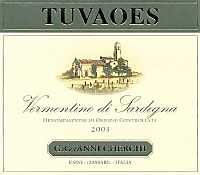
|
|
Vermentino di Sardegna Tuvaoes 2003 |
|
| Giovanni Cherchi (Italy) | |
| Grapes: Vermentino | |
| Price: € 9.00 | Score: |
| This Vermentino shows a pale straw yellow color and nuances of straw yellow, very transparent. The nose reveals intense, clean, pleasing, refined and elegant aromas which start with hints of pear, hawthorn and apple followed by aromas of pineapple, orange, broom, litchi, almond and peach. In the mouth has good correspondence to the nose, a crisp attack and however well balanced by alcohol, good body, intense flavors, agreeable. The finish is persistent with flavors of pear, peach and orange. A well made wine. A small part of the must used for the production of Tuvaoes ferments in barrique. | |
| Food Match: Fried fish, Roasted fish, Broiled fish, Roasted white meat | |
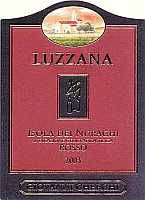
|
|
Luzzana 2002 |
|
| Giovanni Cherchi (Italy) | |
| Grapes: Cagnulari (60%), Cannonau (40%) | |
| Price: € 12.50 | Score: |
| This wine shows an intense ruby red color and nuances of ruby red, little transparency. The nose reveals intense, clean, pleasing and refined aromas which start with hints of cherry and raspberry followed by aromas of blueberry, plum, cyclamen, black currant, violet, tobacco and vanilla. In the mouth has good correspondence to the nose, a slightly tannic attack and however balanced by alcohol, good body, intense flavors, good tannins, agreeable. The finish is persistent with flavors of plum, cherry and raspberry. A well made wine. Luzzana ages for 8-12 months in barrique followed by an aging in bottle of 4 months. | |
| Food Match: Roasted meat, Braised and stewed meat, Hard cheese | |
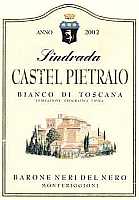
|
|
Sindrada 2003 |
|
| Fattoria di Castel Pietraio (Italy) | |
| Grapes: Chardonnay, Malvasia Bianca | |
| Price: € 6.00 | Score: |
| The wine shows a pale straw yellow color and nuances of straw yellow, very transparent. The nose denotes intense, clean and pleasing aromas which start with hints of apple and hawthorn followed by aromas of pineapple, banana, broom, pear and hints of almonds. In the mouth has good correspondence to the nose, a crisp attack and however balanced, good body, intense flavors. The finish is pretty persistent with flavors of apple and pineapple. | |
| Food Match: Risotto with vegetables, Fried fish, Fish and vegetables appetizers | |
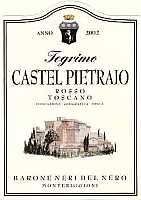
|
|
Tegrimo 2002 |
|
| Fattoria di Castel Pietraio (Italy) | |
| Grapes: Sangiovese | |
| Price: € 12.00 | Score: |
| This wine shows a brilliant ruby red color and nuances of garnet red, little transparency. The nose denotes intense, clean and pleasing aromas which start with hints of black cherry and raspberry followed by aromas of strawberry, blueberry, cyclamen, plum and hints of vanilla. In the mouth has good correspondence to the nose, a slightly tannic attack and pleasing crispness, however balanced by alcohol, good body, intense flavors, good tannins. The finish is persistent with flavors of plum, black cherry and raspberry. Tegrimo ages for 6 months in barrique. | |
| Food Match: Stewed meat with mushrooms, Broiled meat, Hard cheese | |
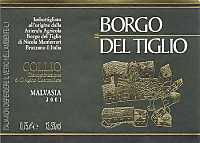
|
|
Collio Malvasia Selezione 2001 |
|
| Borgo del Tiglio (Italy) | |
| Grapes: Malvasia Istriana | |
| Price: € 35.00 | Score: |
| This wine shows a pale straw yellow color and nuances of greenish yellow, very transparent. The nose reveals good personality with intense, clean, pleasing and refined aromas that start with hints of hawthorn and apple followed by aromas of pineapple, peach, almond, plum, grapefruit, toasted wood and vanilla. In the mouth has good correspondence to the nose, a crisp attack and however balanced by alcohol, good body, intense flavors, agreeable. The finish is persistent with flavors of plum and apple. This Malvasia ages in cask. | |
| Food Match: Sauteed fish, Broiled crustaceans, Stuffed pasta with mushrooms | |
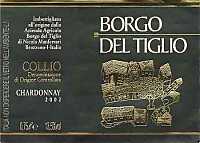
|
|
Collio Chardonnay Selezione 2002 |
|
| Borgo del Tiglio (Italy) | |
| Grapes: Chardonnay | |
| Price: € 35.00 | Score: |
| This wine shows a brilliant straw yellow color and nuances of straw yellow, very transparent. The nose denotes intense, clean, pleasing, refined and elegant aromas which start with hints of toasted wood and plum followed by aromas of hawthorn, banana, pineapple, lily, peach, hazelnut, grapefruit, lavender and vanilla. In the mouth has good correspondence to the nose, a crisp attack and pleasing smoothness, however well balanced by alcohol, good body, intense flavors, agreeable. The finish is persistent with flavors of hazelnut, plum and grapefruit. A well made wine. This Chardonnay ferments and ages in barrique for 9-14 months. | |
| Food Match: Roasted fish, Stuffed pasta, Fish and mushrooms soups, Roasted white meat | |
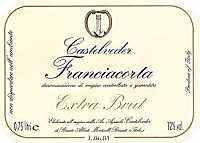
|
|
Franciacorta Extra Brut |
|
| Castelveder (Italy) | |
| Grapes: Chardonnay | |
| Price: € 9.60 | Score: |
| This Franciacorta shows a brilliant greenish yellow color and nuances of greenish yellow, very transparent, good effervescence, fine and persistent perlage. The nose reveals intense, clean, pleasing and refined aromas which start with hints of apple, kiwi and bread crust followed by aromas of hawthorn, yeast, hazelnut, plum and praline. In the mouth has good correspondence to the nose, a crisp and effervescent attack, however balanced, good body, intense flavors. The finish is persistent with flavors of kiwi, apple and plum. This Franciacorta ages on its lees for 25 months. | |
| Food Match: Fried fish, Sauteed fish and crustaceans, Pasta with fish and crustaceans | |
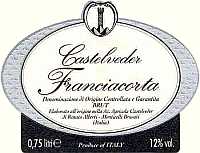
|
|
Franciacorta Brut |
|
| Castelveder (Italy) | |
| Grapes: Chardonnay | |
| Price: € 9.00 | Score: |
| This Franciacorta shows an intense straw yellow color and nuances of straw yellow, very transparent, good effervescence, fine and persistent perlage. The nose denotes intense, clean, pleasing and refined aromas which start with hints of bread crust and yeast followed by aromas of pineapple, banana, hawthorn, beeswax, apple, pear and grapefruit. In the mouth has good correspondence to the nose, a crisp and effervescent attack, however balanced, good body, intense flavors, agreeable. The finish is persistent with flavors of apple and pineapple. This Franciacorta ages on its lees for 25 months. | |
| Food Match: Pasta and risotto with fish and crustaceans, Roasted fish and crustaceans and with mushrooms | |
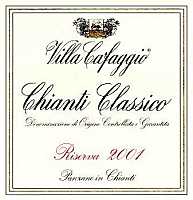
|
|
Chianti Classico Riserva 2001 |
|
| Villa Cafaggio (Italy) | |
| Grapes: Sangiovese | |
| Price: € 23.00 | Score: |
| The wine shows a brilliant ruby red color and nuances of ruby red, little transparency. The nose denotes intense, clean, pleasing and refined aromas which start with hints of plum and black cherry followed by aromas of blueberry, blackberry, violet, vanilla, black pepper, licorice and eucalyptus. In the mouth has good correspondence to the nose, a slightly tannic attack and however well balanced by alcohol, good body, intense flavors, good tannins. The finish is persistent with flavors of plum, black cherry and blueberry. This Chianti ages for 18 months in barrique followed by 5-6 months of aging in bottle. | |
| Food Match: Roasted meat, Braised and stewed meat, Hard cheese | |
|
||||||||
|
DiWineTaste Polls
|
| |||||||
Privacy Policy | |||||||


| Copyright © 2002-2024 Antonello Biancalana, DiWineTaste - All rights reserved |
| All rights reserved under international copyright conventions. No part of this publication and of this WEB site may be
reproduced or utilized in any form or by any means, electronic or mechanical, without permission in writing from DiWineTaste. |